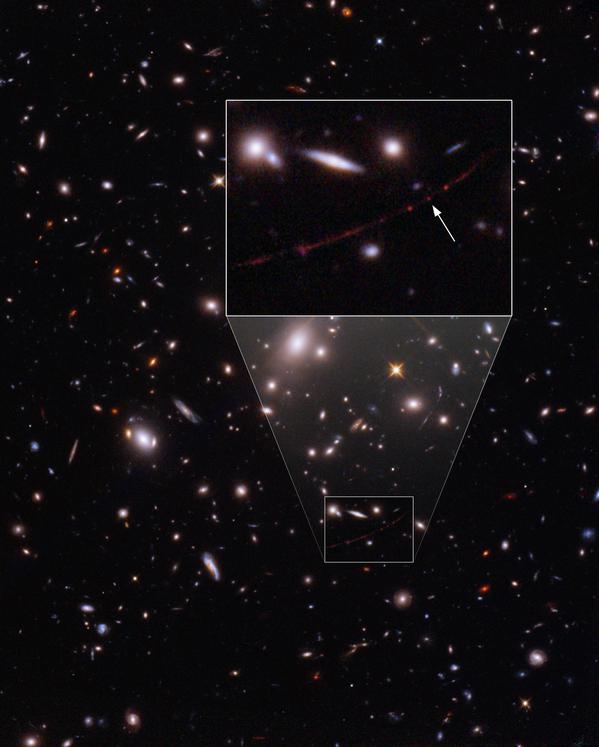This page describes an image A gravitational lens magnifies one of the first stars
Image caption:
This image zooms in on a star formed within the first billion years after the birth of the Universe (at a redshift of 6.2). The Hubble Space Telescope detected this light using a technique called gravitational lensing. A massive galaxy cluster between the observer and the imaged star creates a distorted and warped image of the parent galaxy and reveals its features.
Scroll to captions in other languages
Image credit:
NASA, ESA, B. Welch (JHU), D. Coe (STScI), A. Pagan (STScI) Credit Link
Related glossary terms:
Gravitational Lens
, Star
Categories:
Cosmology
, Stars
Image license: Creative Commons Attribution 4.0 International (CC BY 4.0) Creative Commons Attribution 4.0 International (CC BY 4.0) icons
The media file captions presented on the OAE website were written, translated and reviewed by a collective effort from the OAE, the OAE Centers and Nodes, the OAE National Astronomy Education Coordinators (NAECs) and other volunteers. You can find a full list of credits for our translation project here. All media file captions are released under a Creative Commons CC BY-4.0 license and should be credited to "IAU OAE". The media files themselves may have different licenses (see above) and should be credited as listed above under "credit".
If you notice a factual error in this caption or an error in any of its translations then please get in touch.
Captions in Different Languages:
Image caption: Questa immagine ingrandisce una stella che si é formata nel primo miliardo di anni dopo la nascita dell'Universo (a un redshift di 6,2). Il telescopio spaziale Hubble ha rilevato questa luce grazie ad un fenomeno definito come lente gravitazionale. Un massiccio ammasso di galassie posto tra l'osservatore e la stella fotografata crea un'immagine distorta e deformata della galassia madre e ne rivela le caratteristiche.
Image credit: NASA, ESA, B. Welch (JHU), D. Coe (STScI), A. Pagan (STScI)
Related glossary terms: Lente gravitazionale , Stella Caption translation status: Approved by a reviewer
Caption translators: Giuliana Giobbi
Caption reviewers: Rosa Valiante, Rodolfo Canestrari
Image caption: 这幅图像放大了一颗在宇宙诞生后最初十亿年内形成的恒星(红移为 6.2)。哈勃太空望远镜利用一种叫做引力透镜的技术探测到了这道光。在观测者和被成像的恒星之间有一个巨大的星系团,这就导致了母星系扭曲变形的图像,并揭示了它的特征。
Image credit: NASA, ESA, B. Welch (JHU), D. Coe (STScI), A. Pagan (STScI)
Related glossary terms: 引力透镜 , 恒星 Caption translation status: Not yet approved by a reviewer
Caption translators: Lin Shijie
Image caption: 這幅圖像放大了一顆在宇宙誕生後最初十億年內形成的恆星(紅移為 6.2)。哈勃太空望遠鏡利用一種叫做引力透鏡的技術探測到了這道光。在觀測者和被成像的恆星之間有一個巨大的星系團,這就導致了母星系扭曲變形的圖像,並揭示了它的特徵。
Image credit: NASA, ESA, B. Welch (JHU), D. Coe (STScI), A. Pagan (STScI)
Related glossary terms: 引力透鏡 , 恆星 Caption translation status: Not yet approved by a reviewer
Caption translators: An automated transliteration from the simplified Chinese translation by - Lin Shijie









